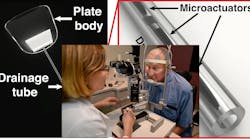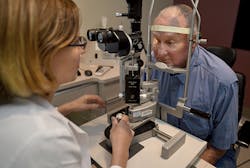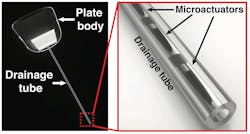A team of Purdue University engineers have invented a drainage device that will help patients with glaucoma, a leading cause of blindness. Glaucoma affects about 3 million Americans and is treated only with medications or surgical implants, both of which offer varying degrees of success in helping to improve sight and to relieve pressure buildup inside the eye.
Implanted drainage devices have grown in popularity over the past years as a method to treat glaucoma, but only half of them remain operational after five years in the patient’s body due to microorganisms building up on the device during and after implantation, a problem known as biofouling.
A new smart drainage device created by Purdue University researchers may help patients with glaucoma save their eyesight.
“We created a drainage device that combats this problem of buildup by being able to clear itself using advances in microtechnology,” says Hyowon “Hugh” Lee, an assistant biomedical engineering professor at Purdue and the team’s leader.
The drain contains microactuators that vibrate when the right magnetic field envelopes the mechanism. The vibrations shake loose any biomaterials that have built up in the tube.
The Purdue University glaucoma drainage device is built with microactuators that vibrate when a magnetic field is introduced. (Image provided by Hyowon Lee)
“We can introduce the magnetic field from outside the body at any time to essentially give the device a refresh,” Lee says. “This on-demand cleaning makes the implant more reliable, safe, and effective for treating glaucoma.”
The Purdue technology is published in the latest issue of Microsystems and Nanoengineering. Another unique aspect of the Purdue device is its ability to vary flow resistance, which physicians customize the drainage for each patient at different stages of glaucoma with varying degrees of pressure buildup inside the eye.



